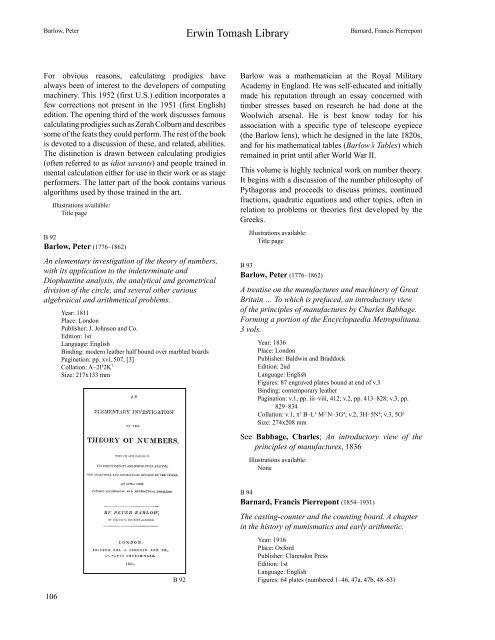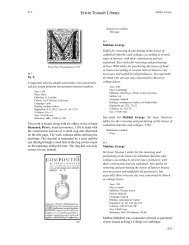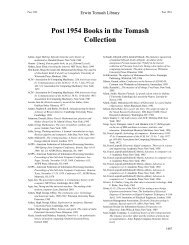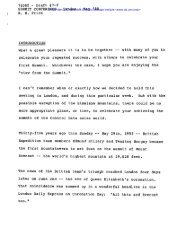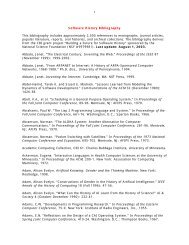B chapter.indd - Charles Babbage Institute - University of Minnesota
B chapter.indd - Charles Babbage Institute - University of Minnesota
B chapter.indd - Charles Babbage Institute - University of Minnesota
You also want an ePaper? Increase the reach of your titles
YUMPU automatically turns print PDFs into web optimized ePapers that Google loves.
For obvious reasons, calculating prodigies have<br />
always been <strong>of</strong> interest to the developers <strong>of</strong> computing<br />
machinery. This 1952 (first U.S.) edition incorporates a<br />
few corrections not present in the 1951 (first English)<br />
edition. The opening third <strong>of</strong> the work discusses famous<br />
calculating prodigies such as Zerah Colburn and describes<br />
some <strong>of</strong> the feats they could perform. The rest <strong>of</strong> the book<br />
is devoted to a discussion <strong>of</strong> these, and related, abilities.<br />
The distinction is drawn between calculating prodigies<br />
(<strong>of</strong>ten referred to as idiot savants) and people trained in<br />
mental calculation either for use in their work or as stage<br />
performers. The latter part <strong>of</strong> the book contains various<br />
algorithms used by those trained in the art.<br />
106<br />
Illustrations available:<br />
Title page<br />
B 92<br />
Barlow, Peter (1776–1862)<br />
An elementary investigation <strong>of</strong> the theory <strong>of</strong> numbers,<br />
with its application to the indeterminate and<br />
Diophantine analysis, the analytical and geometrical<br />
division <strong>of</strong> the circle, and several other curious<br />
algebraical and arithmetical problems.<br />
Year: 1811<br />
Place: London<br />
Publisher: J. Johnson and Co.<br />
Edition: 1st<br />
Language: English<br />
Binding: modern leather half bound over marbled boards<br />
Pagination: pp. xvi, 507, [3]<br />
Collation: A–2I 8 2K 7<br />
Size: 217x133 mm<br />
Erwin Tomash Library<br />
Barlow, Peter Barnard, Francis Pierrepont<br />
B 92<br />
Barlow was a mathematician at the Royal Military<br />
Academy in England. He was self-educated and initially<br />
made his reputation through an essay concerned with<br />
timber stresses based on research he had done at the<br />
Woolwich arsenal. He is best know today for his<br />
association with a specific type <strong>of</strong> telescope eyepiece<br />
(the Barlow lens), which he designed in the late 1820s,<br />
and for his mathematical tables (Barlow’s Tables) which<br />
remained in print until after World War II.<br />
This volume is highly technical work on number theory.<br />
It begins with a discussion <strong>of</strong> the number philosophy <strong>of</strong><br />
Pythagoras and proceeds to discuss primes, continued<br />
fractions, quadratic equations and other topics, <strong>of</strong>ten in<br />
relation to problems or theories first developed by the<br />
Greeks.<br />
Illustrations available:<br />
Title page<br />
B 93<br />
Barlow, Peter (1776–1862)<br />
A treatise on the manufactures and machinery <strong>of</strong> Great<br />
Britain … To which is prefaced, an introductory view<br />
<strong>of</strong> the principles <strong>of</strong> manufactures by <strong>Charles</strong> <strong>Babbage</strong>.<br />
Forming a portion <strong>of</strong> the Encyclopaedia Metropolitana.<br />
3 vols.<br />
Year: 1836<br />
Place: London<br />
Publisher: Baldwin and Braddock<br />
Edition: 2nd<br />
Language: English<br />
Figures: 87 engraved plates bound at end <strong>of</strong> v.3<br />
Binding: contemporary leather<br />
Pagination: v.1, pp. iii–viii, 412; v.2, pp. 413–828; v.3, pp.<br />
829–834<br />
Collation: v.1, π 3 B–L 4 M 2 N–3G 4 ; v.2, 3H–5N 4 ; v.3, 5O 3<br />
Size: 274x208 mm<br />
See <strong>Babbage</strong>, <strong>Charles</strong>; An introductory view <strong>of</strong> the<br />
principles <strong>of</strong> manufactures, 1836<br />
Illustrations available:<br />
None<br />
B 94<br />
Barnard, Francis Pierrepont (1854–1931)<br />
The casting-counter and the counting board. A <strong>chapter</strong><br />
in the history <strong>of</strong> numismatics and early arithmetic.<br />
Year: 1916<br />
Place: Oxford<br />
Publisher: Clarendon Press<br />
Edition: 1st<br />
Language: English<br />
Figures: 64 plates (numbered 1–46, 47a, 47b, 48–63)


